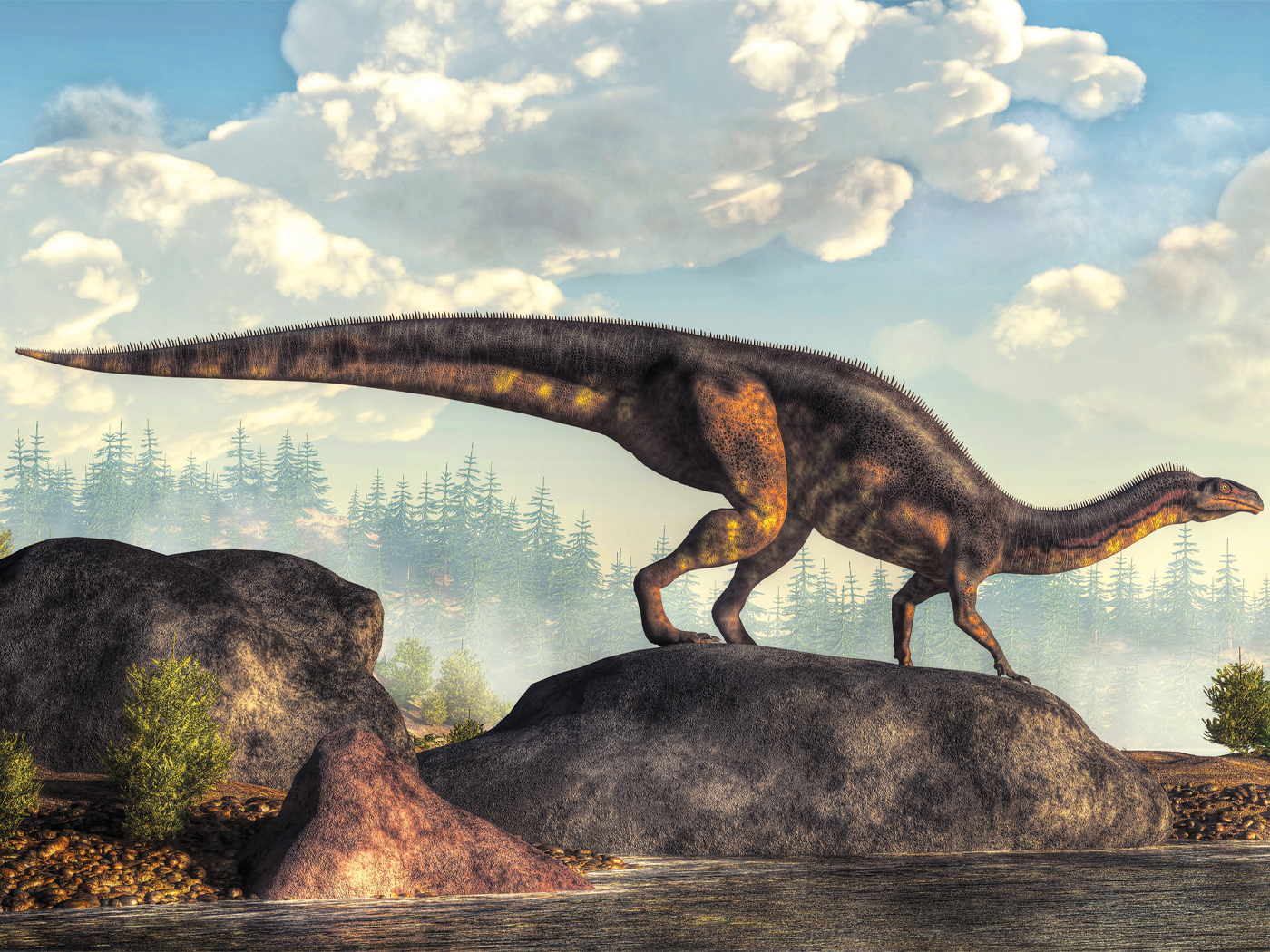Introduction
Much attention has been given to how the animals would be brought to, fit in, and survive on Noah's Ark.[1] But little or no concern has been voiced as to how aquatic animals could have lived outside in the Flood. Obviously, terrestrial air-breathing animals could not live through the land-covering deluge, but one would think aquatic animals would be right at home in all that water. Not so!
Water life has specific physiological and ecological requirements just like terrestrial life.[2] A catastrophe the size of the Flood would certainly bring with it gigantic problems affecting the very survival of many species. Indeed, the fossil record indicates that many taxonomic groups became extinct during the deposition of the geologic sedimentary layers.[3] Some organisms would have simply succumbed to the trauma of the turbulence. Others would have found suitable living space destroyed, and hence died for lack of appropriate habitat. For example, too much fresh water for obligate (bound to) marine species or vice versa would have led to death of those unable to adapt. Not only are there salt-concentration problems, but also temperature, light, oxygen, contaminants, and nutritional considerations. These must all be evaluated in discussing survival of water-dwelling creatures.
To simplify the exercise, five examples have been selected of fishes that are bound to fresh or salt water and those that can go between these major habitats. The chosen fishes (sunfish, catfish, trout, eel, and codfish) will be used to represent clear fresh water, muddy fresh water, anadromous (running up to fresh water from sea water to spawn), catadromous (the reverse) and obligate marine habitats or behavior, respectively. These categories will be discussed with reference to three main factors affecting their survival: salinity, temperature, and turbidity.
PHYSIOLOGICAL RANGES
Salinity
Fish have a problem in balancing the fluids outside their bodies with those inside. In general, freshwater fishes are constantly getting too much fresh water in their bodies from food, drinking water, and tissue transfer. On the opposite side, marine fishes get too little fresh water to maintain fluid balance due to the large input of salt in the drinking water and constant osmotic pressure to draw fresh water out of these tissues into the surrounding sea.[4]
The kidneys and gills are the two organs used to manage this balance. If a freshwater fish gets too much water, then the kidney is called upon to dump as much water as possible while retaining the circulating salts. Marine bony fish have to get rid of the excess salts largely through the gills and conserve the internal water through resorption.
Sea-run trout move from sea water to fresh water to spawn, while eels do just the opposite. Both have to be able to reverse their removal of water and salt according to the amount of salt in their environment. Sun fishes and cod remain in fresh water and sea water, respectively, for their whole life cycle. Salt content might range from nearly zero in freshwater to 35 parts per thousand (x103 ppm or 35,000 mg/l) in sea water. Obligate freshwater fish typically have an upper lethal level of seven parts per thousand (7,000 mg/l). Obligate marine species have a very narrow limit of salt tolerance.[5] Dromous (running/migrating) species are able to adapt to the new environments by osmotic regulation.
Temperature
The range of temperatures tolerated by fishes varies from species to species and the assorted habitats. Some fish have a very narrow range of tolerance at the cold, warm, or hot temperature parts of the heat scale. Others show a wide range of heat tolerance from freezing to hot waters (0-32° C). Developmental stages are frequently limited by narrow temperature requirements within the overall range of the adult.
Most species, including cold-water types, can tolerate at least brief exposures to 24°C and low temperatures approaching 2°C, as long as there are prolonged acclimation periods (several days to weeks). Preferred temperatures for the representative adult fish are as follows: Trout, 16-21°C; sunfish, 16-28°C; catfish, 21-29°C; eel, probably 16-28°C; codfish 12-16° C. [6,7]
Turbidity
Particulate matter that is in suspension in natural waters is measured photoelectrically as turbidity. It consists of erosional silt, organic particles, bacteria, and plankton. Such materials adversely affect fish by covering the substrate with a smothering layer that kills food organisms and spawning sites. In addition, the molar action of the silt damages gills and invertebrate respiratory structures. Fish combat such materials by secreting mucus that carries the particles away. Indirectly, turbidity screens out light and decreases the photic zone for photosynthesis. The range of turbidity might be described as: clear < 10 ppm (mg/l), turbid 10 to 250 ppm, and very turbid > 250 ppm. Wallen[8] found that many fish species survive turbidities of 100,000 ppm for one week or more.
SURVIVAL STRATEGY
Runoff to the Ocean
Heavy rainfall over the land would quickly fill the river basins with torrential flows. These in turn would empty out onto the encroaching coastline as a freshwater blanket. Odum[5] refers to situations similar to this as a "highly stratified or `salt-wedge' estuary." Such a massive freshwater outflow from the continents would join with the oceanic rainfall to form a halocline or strong density gradient, in which fish flushed out from the land aquatic systems could continue to survive in a freshwater environment. Stratification like this might even survive strong winds, if the freshwater depth was great enough to prevent internal current mixing. Thus, a situation might be envisioned where freshwater and marine fishes could survive the deluge in spite of being temporarily displaced.
Turbidity Flows
On the other hand, large turbid particles and enormous bedloads could move into the ocean as settleable particulate rain and ground-hugging slurries. Heavier particles would fall out in the slower-moving coastal waters, and the mudflows would sediment out over the ocean floor. Although there would be turbulence at the freshwater/saltwater interface, the particle insertion would probably occur without appreciable mixing. With the range of tolerance given above, many fishes might be able to survive extended exposure to high turbidity .
Serendipity at Mount St. Helens
The biotic recovery at Mount St. Helens after the May 18, 1980 eruption demonstrates rapid and widely ranging restoration. Obviously, the Flood would have been one or more orders of magnitude greater a catastrophe than that eruption. But such an event does help us to see ways of recovery.
| April 4, 1980 | June 30, 1980 | |
| Alkalinity (mg/l) | 0.01 | 150.5 |
| Temperature (°C) | 4.0 | 22.4 |
| Turbidity (mg/l) | 0.75 | 24.61 |
With regard to the three factors of interest (salinity—approximately alkalinity, in the sense of dissolved solutes—, temperature, and turbidity), significant changes were seen in the affected areas (data transformed to units used previously).[9,10]
Still, a little more than a month after the eruption, the lake most exposed to the catastrophic event, Spirit Lake, had tolerable alkalinity, ambient temperature, and low turbidity. This is not to deny that all the endemic fish were killed in the event and probably could not have survived if replanted in these waters on June 30, 1980, due to large organic oxygen demands from decaying tree debris and seeps of methane and sulfur dioxide. But within ten years, the lake appears to be able to support fish, as many other aquatic species are back and well established. If the lake were connected directly to the Toutle River, then salmonids probably would have made their reentry by this time.
Perhaps the most significant observation, though, in examining the post-eruption history, is that a variety of habitats within and adjacent to the blast zone survived the event with minimal impact on the continuity of the ecosystem. Meta Lake, within the blast zone for example, had an ice cover at the time of the searing blast, which protected the dormant ecosystem from experiencing much disruption from the heat, anoxia, and air-fall tephra. Fish and support systems picked up where they left off before the onset of the winter season.
Similar experiences were observed in Swift Reservoir, in spite of massive mud and debris flows into the lake by way of Muddy Creek (personal conversation with aquatic biologist on duty at that time). Fish were displaced into the adjacent unaffected watersheds or downstream into lower reservoirs. However, within two years, massive plankton blooms had occurred and ecosystem recovery was well underway with migrant recruits.
Such a confined catastrophe (500 square miles) enables one to project expectations from a major catastrophe, such as the Flood. First, in spite of the enormous magnitude of such events, there appear to be refuges for survival even in close proximity to the most damaging action. Second, recovery can be incredibly fast—from one month to ten years. Third, recruitment from minimally affected zones can occur with normal migratory behavior of organisms. Although some animal and plant populations or even species might be annihilated in such events, remnant individuals can reestablish new populations.
References
- John C. Whitcomb and Henry M. Morris, The Genesis Flood (Presbyterian and Reformed Publishing Co.,1961), pp. 63-79.
- M. M. Ellis, "Detection and Measurement of Stream Pollution" in Lowell E. Keup, William M. Ingram, and Kenneth M. Mackenthun, Biology of Water Pollution (U.S. Dept. of Interior, Federal Water Pollution Control Administration, 1967), pp. 129-185.
- John C. Briggs, "A Cretaceous-Tertiary Mass Extinction?" BioScience 41 (1991), pp. 619-624.
- Ernst Florey, An Introduction to General and Comparative Animal Physiology (Philadelphia, W. B. Saunders Co., 1966), pp. 97-110.
- Eugene P. Odum, Fundamentals of Ecology (Philadelphia, W. B. Saunders Co., 1971), pp. 328,354.
- Alex Calhoun, Inland Fisheries Management (State of California , The Resource Agency, Department of Fish and Game, 1966), pp. 194, 375, 448.
- William A. Anikouchine and R. W. Sternberg, The World Ocean: An Introduction to Oceanography (Englewood Cliffs, N.J., Prentice Hall, Inc., 1973), pp. 215, 223.
- I. E. Wallen, "The Direct Effect of Turbidity on Fishes," Oklahoma Agric. and Mech. College Bulletin 48 (1951), pp. 18-24.
- Robert C. Wissmar, Allan H. Devol, Ahmad E. Nevissi, James R. Sedell, "Chemical Changes of Lakes Within the Mount St. Helens Blast Zone," Science 216 (1982), pp. 175-178.
- Robert C. Wissmar, Allan H. Devol, James T. Staley, and James R. Sedell, "Biological Responses of Lakes in the Mount St. Helens Blast Zone," Science 216 (1981), pp. 178-181.
* Dr. Kenneth Cumming is Professor of Biology and Dean at the ICR Graduate School.













